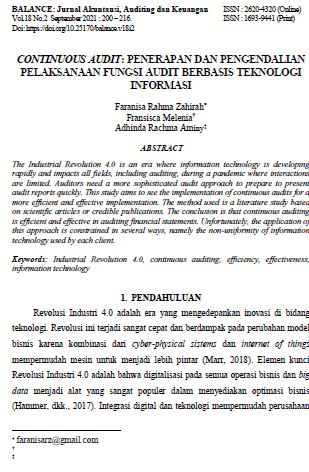CONTINUOUS AUDIT: PENERAPAN DAN PENGENDALIAN PELAKSANAAN FUNGSI AUDIT BERBASIS TEKNOLOGI INFORMASI
DOI:
https://doi.org/10.25170/balance.v18i2.3136Keywords:
Industrial Revolution 4.0, continuous auditing, information technology, efficiency, effectivenessAbstract
The Industrial Revolution 4.0 is an era where information technology is developing rapidly and impacts all fields, including auditing, during a pandemic where interactions are limited. Auditors need a more sophisticated audit approach to prepare to present audit reports quickly. This study aims to see the implementation of continuous audits for a more efficient and effective implementation. The method used is a literature study based on scientific articles or credible publications. The conclusion is that continuous auditing is efficient and effective in auditing financial statements. Unfortunately, the application of this approach is constrained in several ways, namely the non-uniformity of information technology used by each client.
References
Elisabeth, D. M. (2019). Kajian terhadap peranan teknologi informasi dalam perkembangan audit komputerisasi (Studi kajian teoritis). METHOMIKA: Jurnal Manajemen Informatika & Komputerisasi Akuntansi, 3(1), 41.
Eulerich, M., Georgi, C., & Schmidt, A. (2020). Continuous auditing and risk-based audit planning—An empirical analysis. Journal of Emerging Technologies in Accounting, 17(2), 141–155. Https://Doi.Org/10.2308/JETA-2020-004.
Hammer, M., Somers, K., Karre, H., & Ramsauer, C. (2017). Profit per hour as a target process control parameter for manufacturing sistems enabled by big data analytics and industry 4.0 infrastructure. Procedia CIRP, 63, 715–720. Https://Doi.Org/10.1016/J.Procir.2017.03.094.
Hazzar, H. B. (2020). New paradigm in auditing: Continuous auditing. Ethics and Sustainability in Accounting and Finance. II. 253-265.
Hiererra, S. E., & Sarayar, M. O. I. (2014). Continuous audit: Implementasi dan pengendalian berbasis teknologi informasi dalam menjalankan fungsi audit yang lebih efektif dan efisien. Comtech: Computer, Mathematics and Engineering Applications, 5(2), 763. Https://Doi.Org/10.21512/Comtech.V5i2.2238.
Iswandir. (2019). Audit sistem informasi akuntansi berbasis komputer dalam penyajian financial report. JSI (Jurnal Sistem Informasi) Universitas Suryadarma, 6, 171–178.
Kurniasari, S. R. (2019). Continuous auditing sistem: Implementasi audit berbasis teknologi pada PT Semen Indonesia (Persero) Tbk. Universitas Airlangga.
Kilpatrick, J., Barter, L., & Dess, J. (2020). COVID-19 Managing cash flow during a period of crisis. Deloitte, 10. Retrieved From Https://Www2.Deloitte.Com/Content/Dam/Deloitte/Global/Documents/About-Deloitte/Gx-COVID-19-Managing-Cash-Flow-In-Crisis.Pdf.
Kurniawan, T. A. (2017). Continuous audit: Tantangan dalam implementasi. akuntansi dewantara, 1(2), 152–159. Retrieved From Http://Jurnal.Ustjogja.Ac.Id/Index.Php/Akuntansidewantara/Article/View/1567.
Marr, B. (2018). What is Industry 4.0? Here’s a super easy explanation for anyone. Retrieved March 17, 2021, From Https://Www.Forbes.Com/Sites/Bernardmarr/2018/09/02/What-Is-Industry-4-0-Heres-A-Supereasy-Explanation-For-Anyone/?Sh=6582108f9788.
Maulidiastuti, T., Suratno, & Yusuf, M. (2018). Analisis peran akuntansi forensik, data mining, continuous auditing, terhadap pendeteksian fraud serta dampaknya pada pencegahan fraud. Ekobisman, 3(2), 104–121.
Martusa, R., Carolina, V., & Meythi. (2012). Continuous auditing: Strategi pengauditan berbasis teknologi informasi. Maksi, 449–465.
Murfidyah, A., Suntoro, A. N. V., Putri, A. A., & Putri, C. K. (2021). Penerapan audit berbasis IT di era digital: Peluang atau tantangan? E-Prosiding National Seminar on Accounting, Finance, Murfidyah, Almira, Et Al.,E-Prosiding National Seminar on Accounting, Finance, and Economics (NSAFE), 1(1), 24–33.
Nezhyva, M., & Miniailo, V. (2020). Digitalization of audit, 2020(131), 123–134.
Ramon, A., Santana, A. De, & Caetano, P. (2021). Auditmodel : A Model for representation of continuous audit processes based on ISO 19011, 77, 30–47.
Setyawan, E. C. (2018). Mewujudkan continuous auditing di lingkungan inspektorat jenderal, 1–14.
Swastika, I. P. A., & Putra, G. L. A. R. (2016). Audit sistem informasi dan tata kelola teknologi informasi: implementasi dan studi kasus. Yogyakarta: CV Andi Offset.
Syafei, N. (2015). Effect of it governance, continuous auditing and it goals alignment to company’s performance (Study on plantation companies in the group of PT. Astra Agro Lestari Tbk in Riau). Al-Iqtishad, 1, 45–58.
Torkura, K. A., Sukmana, M. I. H., Cheng, F., & Meinel, C. (2021). Continuous Auditing and threat detection in multi-cloud infrastructure. Computers and Security, 102(102124). Https://Doi.Org/Https://Doi.Org/10.1016/J.Cose.2020.102124.
Vasarhelyi, M. A., & Halper, F. B. (2018). The continuous audit of online systems. Continuous Auditing, (January 1991), 87–104. Https://Doi.Org/10.1108/978-1-78743-413-420181004.
Zhou, J. (2013). Digitalization and intelligentization of manufacturing industry. Advances in Manufacturing, 1(1), 1–7. Https://Doi.Org/10.1007/S40436-013-0006-5.



